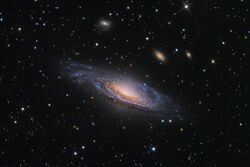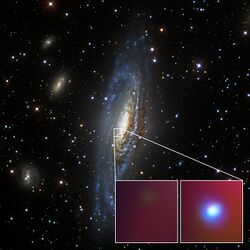Astronomy:NGC 7331
| NGC 7331 | |
|---|---|
 NGC 7331 imaged by the Phillips 24-inch RCOS Telescope at the Mount Lemmon SkyCenter[1] | |
| Observation data (J2000 epoch) | |
| Constellation | Pegasus |
| Right ascension | 22h 37m 04.0624s[2] |
| Declination | +34° 24′ 56.721″[2] |
| Redshift | 816 ± 1 km/s[2] |
| Distance | 39.8 ± 3.3 Mly (12.2 ± 1.0 Mpc) [3] |
| Apparent magnitude (V) | 10.4[2] |
| Characteristics | |
| Type | SA(s)b[2] |
| Size | 146,250 ly (44.85 kpc) (estimated)[2] |
| Apparent size (V) | 10.5′ × 3.7′[2] |
| Other designations | |
| Caldwell 30, HOLM 795A, IRAS 22347+3409, UGC 12113, MCG+06-49-045, PGC 69327[2] | |
NGC 7331, also known as Caldwell 30, is an unbarred spiral galaxy about 40 million light-years (12 Mpc) away in the constellation Pegasus. It was discovered by William Herschel on 6 September 1784.[4]
The galaxy appears similar in size and structure to the Milky Way, and is sometimes referred to as "the Milky Way's twin".[5] However, discoveries in the 2000s regarding the structure of the Milky Way may call this similarity into doubt, particularly because the latter is now believed to be a barred spiral, compared to the unbarred status of NGC 7331.[6] In spiral galaxies the central bulge typically co-rotates with the disk but the bulge in the galaxy NGC 7331 is rotating in the opposite direction to the rest of the disk.[7] In both visible light and infrared photos of the NGC 7331, the core of the galaxy appears to be slightly off-center, with one side of the disk appearing to extend further away from the core than the opposite side.
Galaxy Groups
NGC 7331 is the brightest galaxy in the field of a visual grouping known as the NGC 7331 Group of galaxies. In fact, the other members of the group, NGC 7335, NGC 7336, NGC 7337 and NGC 7340, lie far in the background at distances of approximately 300–350 million light years.[8]
All of the members of the NGC 7331 Group, along with NGC 7325, NGC 7326, NGC 7327, NGC 7333, NGC 7338, are listed together as Holm 795 in Erik Holmberg's A Study of Double and Multiple Galaxies Together with Inquiries into some General Metagalactic Problems, published in 1937.[9]
Supernovae
Four supernovae have been observed in NGC 7331:
- SN 1959D (Type II-L, mag. 13.4) was discovered by Milton Humason and H. S. Gates in a survey at Palomar Observatory on 28 June 1959.[10][11][12]
- SN 2013bu (Type II, mag. 16.6) was discovered by Kōichi Itagaki on 21 April 2013.[13]
- SN 2014C was discovered by the Lick Observatory Supernova Search (LOSS) on 5 January 2014.[14] The supernova underwent an unusual "metamorphosis" from a hydrogen-poor Type Ib to a hydrogen-rich Type IIn over the course of a year.[15]
- SN 2025rbs (Type Ia, mag. 17.07) was discovered by GOTO on 14 July 2025.[16]
- In addition to the confirmed supernovae, a 1903 photographic plate from Yerkes Observatory shows a magnitude 16.6 candidate transient that may have also been a supernova.[17]
See also
- M94 – another galaxy with a prominent starburst ring
- NGC 1512 – another galaxy with a prominent starburst ring
- Flocculent spiral galaxy
- List of NGC objects (7001–7840)
References
- ↑ Block, Adam (1 September 2009). "NGC 7331". University of Arizona. https://skycenter.arizona.edu/astrophotography/ngc7331.
- ↑ 2.0 2.1 2.2 2.3 2.4 2.5 2.6 2.7 "NASA/IPAC Extragalactic Database". Results for object NGC 7331. https://ned.ipac.caltech.edu/byname?objname=ngc+7331.
- ↑ Jensen, Joseph B.; Tonry, John L.; Barris, Brian J.; Thompson, Rodger I. et al. (February 2003). "Measuring Distances and Probing the Unresolved Stellar Populations of Galaxies Using Infrared Surface Brightness Fluctuations". Astrophysical Journal 583 (2): 712–726. doi:10.1086/345430. Bibcode: 2003ApJ...583..712J.
- ↑ The NGC/IC Project : NGC Discoverers List by Bob Erdmann.
- ↑ "Seeing Double: Spitzer Captures Our Galaxy's Twin". Spitzer Space Telescope Newsroom. Spitzer Science Center. 2004-06-28. http://www.spitzer.caltech.edu/Media/releases/ssc2004-12/release.shtml.
- ↑ "The Milky Way Has Only Two Spiral Arms". 2008-06-03. http://www.universetoday.com/2008/06/03/the-milky-way-has-only-two-spiral-arms/#more-14694.
- ↑ A Counter-rotating Bulge in the Sb Galaxy NGC 7331 , F. Prada, C. Gutierrez, R.F. Peletier, C.D. McKeith, the Astrophysical Journal, 463 :L9–L12, 20/5/1996
- ↑ "Spiral Galaxy NGC 7331, Galaxy Group (NGC 7335, 7336, 7337)". http://www.kopernik.org/images/archive/n7331.htm.
- ↑ Holmberg, Erik (1937). "A Study of Double and Multiple Galaxies Together with Inquiries into some General Metagalactic Problems". Annals of the Observatory of Lund 6: 1. Bibcode: 1937AnLun...6....1H.
- ↑ "NASA/IPAC Extragalactic Database". Results for SN 1959D. https://ned.ipac.caltech.edu/byname?objname=sn+1959d.
- ↑ M. L. Humason; H. S. Gates (1960). "The 1959 Palomar Supernova Search". Publications of the Astronomical Society of the Pacific 72 (426): 208–209. doi:10.1086/127513. Bibcode: 1960PASP...72..208H.
- ↑ "SN 1959D". IAU. https://www.wis-tns.org/object/1959D.
- ↑ "SN 2013bu". IAU. https://www.wis-tns.org/object/2013bu.
- ↑ "SN 2014C". IAU. https://www.wis-tns.org/object/2014C.
- ↑ D. Milisavljevic (2015). "Metamorphosis of SN 2014C: Delayed Interaction Between a Hydrogen Poor Core-collapse Supernova and a Nearby Circumstellar Shell". The Astrophysical Journal 815 (2): 120. doi:10.1088/0004-637X/815/2/120. Bibcode: 2015ApJ...815..120M.
- ↑ "SN 2025rbs". IAU. https://www.wis-tns.org/object/2025rbs.
- ↑ Cerny et al. (2021). "Precise Photometric Measurements from a 1903 Photographic Plate Using a Commercial Scanner". Publications of the Astronomical Society of the Pacific 133 (1022): 044501. doi:10.1088/1538-3873/abec20. Bibcode: 2021PASP..133d4501C.
External links
- Calar Alto Observatory – NGC 7331
- APOD (2004-07-01) – "A Galaxy So Inclined"
- SST – "Morphology of Our Galaxy's 'Twin'"
- NGC 7331 at the astro-photography site of Mr. T. Yoshida
- NGC7331 at W. Kloehr Astrophotography
- NGC 7331 on WikiSky: DSS2, SDSS, GALEX, IRAS, Hydrogen α, X-Ray, Astrophoto, Sky Map, Articles and images
- SEDS – NGC 7331
Coordinates: ![]() 22h 37m 04.0624s, +34° 24′ 56.721″
22h 37m 04.0624s, +34° 24′ 56.721″
 |


